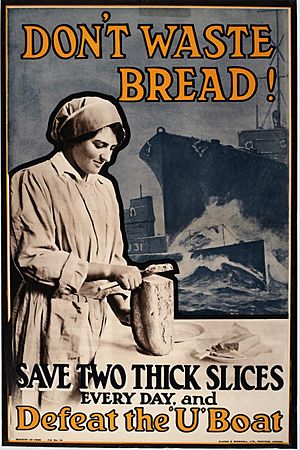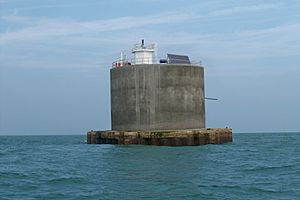Admiralty M-N Scheme facts for kids
The Admiralty M-N Scheme (also called "Project M-N") was a secret British plan during World War I. Its goal was to block the Strait of Dover in the English Channel. This would stop German U-boats (submarines) from using this route. The plan involved building a line of eight or twelve huge towers. These towers would be connected by special anti-submarine nets and barriers. However, only two towers were built before the war ended in November 1918. The project was then stopped.
Contents
Why the Plan Started
On January 31, 1917, Germany announced a new strategy. They would start sinking ships without warning again. This was called unrestricted submarine warfare. It began on February 1. At first, this new U-boat campaign was very successful. German submarines sank nearly 500,000 tons of ships in February and March. In April, they sank 860,000 tons. Britain's food supply, especially wheat, dropped to only six weeks' worth. This was a very serious problem.
The British Admiralty (the navy's command) worked harder to find ways to stop the U-boats. They focused on the Strait of Dover. German U-boats based in Bruges, Belgium, used this strait. It gave them a quick way to reach the Atlantic Ocean and busy shipping lanes. If the strait could be blocked, U-boats would have to take a much longer route. They would have to go around the north of Scotland. This would mean less time for them to patrol and attack ships.
Earlier Efforts to Block the Strait
Britain already had some defenses in the Strait of Dover. The Dover Patrol used cruisers and destroyers to guard the area. There was also the Dover Barrage. This was a line of strong steel anti-submarine nets. It also had minefields stretching across the strait. Destroyers, armed fishing boats (trawlers), and small fishing boats (drifters) patrolled this line. They used powerful searchlights to spot submarines. Work on this barrier started in 1915.
The Dover Barrage improved in mid-1917 with new mines. But it was not very successful at first. This was because there was no clear agreement on how deep the mines should be placed. By December 1917, only two U-boats had been destroyed by the barrier. Also, the patrol boats were in danger from German torpedo boats. There were battles in the Strait of Dover in October 1916 and April 1917.
A New Idea for Defense
Sir Alexander Gibb, the chief engineer for the Admiralty, came up with a new plan. He suggested building eight or twelve large towers. These towers would be made of concrete and steel. They would be placed on the seabed across the Dover Strait. They would stretch from Folkestone in England to Cap Gris Nez in France. Stronger anti-submarine nets would be stretched between these towers. Each tower would have two 4-inch guns and searchlights. They would also have special listening devices called hydrophones to detect submarines.
Gibb had also worked on a submarine detection system with T G Menzies and Colonel William McLellan. This system used a device called a galvanometer. This technology was also planned for the towers. Each tower would have living space for 100 men.
Building the Towers
In June 1918, a group of Royal Engineers arrived in Southwick Green, Sussex. They set up a camp there. Soon, construction began on the first two towers. They were built near Shoreham harbour. Each tower had a base that was 80 feet (25 meters) high. This base was made of strong reinforced concrete cells. On top of this base was a 1,000-ton steel column. This column was 90 feet (27.5 meters) high and 40 feet (12 meters) wide.
The entire project was going to cost £12 million. This was a huge amount of money at the time. The towers became very visible from far away. Local people called them the "Shoreham mystery towers." When the Armistice (the agreement to stop fighting) happened in November 1918, the whole project was canceled. Only Tower Number 1 was almost finished.
What Happened Next
Tower Number 1 soon found a new purpose. It was used to replace the Nab Rock lightship. This lightship was 40 miles away, off Bembridge in the Isle of Wight. On September 12, 1920, five navy tugboats pulled the tower out of Shoreham harbour. Thousands of people watched this event. The next day, the tower was sunk onto a sandbar next to the Nab Rock. This tower, now called the Nab Tower, is still used today as a lighthouse.
The second tower stayed at Shoreham until 1924. It took six months to take it apart. One of the Royal Engineer officers who worked on building the towers was Guy Maunsell. He later designed the Maunsell Sea Forts for defense in World War II.
Images for kids





